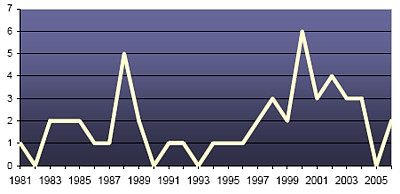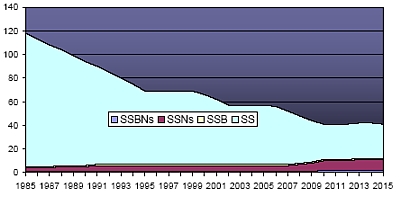China’s Submarine Fleet Continues Low Patrol Rate

China’s entire submarine fleet conducted only two patrols in 2006, according to information declassified by the U.S. Navy and obtained by the Federation of American Scientists under the Freedom of Information Act. The low patrol rate follows a drop from an all-time high of only six patrols in 2000 to none in 2005. China’s single sea-launched ballistic missile submarine Xia, the data shows, has never conducted a deterrent patrol.
The low level of Chinese submarine patrols is a curious contrast to warnings by the Pentagon, some private institutes and news media that China is expanding its submarine operations deeper into the Pacific. Although Chinese submarines occasionally venture into the waters around Japan and Taiwan, the fleet is surprisingly inactive.
Since 1981, the first year for which patrol data is available, the Chinese submarine force has conducted an average of less than two patrols per year. The highest number of annual patrols conducted since 1981 was six patrols in 2000. In four years (1982, 1990, 1993 and 2005), no patrols were conducted at all. Over the 25-year period, the trend is that patrols have only increased from one per year to approximately 2.8 patrols per year.
|
Chinese Submarine Patrols |
 |
| The entire Chinese submarine fleet conducts less than three patrols per year on average. The ballistic missile submarine Xia has never conducted a deterrent patrol. |
So What is a Patrol?
The Navy has refused to tell FAS what a “patrol” is, saying doing so “would divulge methods and sources.” So interpretation of the data comes with a great deal of uncertainty. But the Defense Department’s unclassified Dictionary of Military Terms (JP 1-02) and earlier versions provide some hints by listing the following five definitions:
* Antisubmarine patrol: The systematic and continuing investigation of an
area or along a line to detect or hamper submarines, used when the direction
of submarine movement can be established.
* Inshore patrol: A naval defense patrol operating generally within a naval
defense coastal area and comprising all elements of harbor defenses, the
coastal lookout system, patrol craft supporting bases, aircraft, and Coast
Guard stations.
* Offshore patrol: A naval defense patrol operating in the outer areas of
navigable coastal waters. It is a part of the naval local defense forces
consisting of naval ships and aircraft and operates outside those areas
assigned to the inshore patrol.
* Patrol: A detachment of ground, sea, or air forces sent out for the purpose
of gathering information or carrying out a destructive, harassing, mopping up,
or security mission.
* Submarine patrol area: A restricted area established to allow submarine
operations: a. unimpeded by the operation of, or possible attack from, friendly
forces in wartime; b. without submerged mutual interference in peacetime.
If one assumes that U.S. Naval Intelligence’s use of the term “patrol” follows the DOD’s definitions, then the declassified patrol data suggests that Chinese general purpose submarines in 2006 twice conducted investigations to detect other submarines, participated in naval defense operations in coastal or outside coastal areas, or deployed for the purpose of gathering information or harassing. That implies an almost dormant submarine fleet.
The Song Incident
One of the two patrols conducted in 2006 appears to have been the widely reported surfacing of a Song-class diesel-electric submarine near the U.S. aircraft carrier USS Kitty Hawk in the South China Sea. The news media and pundits dramatized the incident as an example of China expanding its submarine operations, the Chinese government downplayed the reports as inaccurate, and the Pentagon said the media made too much of the incident.
“The bottom line is that […] they’re deploying them further and more frequently,” Defense News quoted an expert on the Chinese Navy at the National Defense University saying. China might even have a decisive submarine surge capability in 20 years, another pundit argued. “They are building a blue-water navy,” yet another expert warned. A politician in Taiwan thought it raises questions about “whether the U.S. in losing its military edge in the Western Pacific,” and commentators in both Taipei and Washington concluded that the incident showed that Taiwan needs to buy more submarines.
The Pentagon’s 2006 report Military Power of the People’s Republic of China stated that China was working on establishing a “first” or “second island chain” strategy for its naval forces, and that “Chinese forces have increased operations beyond China’s borders and coastal waters.” This may be the case for surface ships, but to illustrate the development the Pentagon highlighted “the highly publicized 2004 intrusion of a HAN-class nuclear submarine in Japanese territorial waters during operations far into the western Pacific Ocean.” DOD did not mention that the intrusion was one of only three patrols conducted by the entire Chinese submarine force in 2004, and that no patrols at all were conducted in 2005.
The U.S.-China Commission established by Congress after reports about Chinese spying, stated in 2006 that China is pursuing measures to try to “control” the seas in the Western Pacific, although “controlling” the seas is a daunting technological and operational task, and that China continues to “expand” its submarine force.
The Shrinking Chinese Submarine Fleet
Although China is modernizing its submarine force, it is not “expanding” it. Since the mid-1980s, the force has been in steady decline from nearly 120 boats to roughly 55 operational submarines today. The U.S. Navy expects the force will level out around 40 boats in the next decade.
|
The Shrinking Chinese Submarine Fleet |
 |
| The Chinese submarine fleet has declined by approximately 50 percent since the mid-1980s, mainly due to retirement of old and obsolete classes. Construction of new classes is underway but is not anticipated to lead to an increase, as the U.S. Navy expects the fleet will level out at around 40 submarines in the next decade. |
The decline of the submarine fleet is part of a transition where large older classes are being phased out and replaced with newer but less numerous submarine classes. The new submarines are more capable than the ones they replace, but the modernization has not resulted in an increase in the number of submarine patrols. On the contrary, during the period between 2000 and 2006, when China acquired a dozen new Kilo and Song class submarines, the number of patrols declined from six to two (with no patrols at all in 2005).
Implications
The implications of the low patrol rate are significant. The total operational experience for the entire Chinese submarine force is only 49 patrols in 25 years, corresponding to each submarine conducting an average of one patrol every third year.
As a result, Chinese submarine crews appear to have relatively little operational experience and consequently limited skills in operating their boats safely and competently. It suggests that the tactical skills that would be needed for the Chinese submarine force to operate effectively in a war may be limited.
China continues – at least for now – to use its submarine force as a coastal defense force.
Background: Chinese Nuclear Forces and U.S. Nuclear War Planning
The FY2026 National Defense Authorization Act (NDAA) paints a picture of a Congress that is working to both protect and accelerate nuclear modernization programs while simultaneously lacking trust in the Pentagon and the Department of Energy to execute them.
While advanced Chinese language proficiency and cultural familiarity remain irreplaceable skills, they are neither necessary nor sufficient for successful open-source analysis on China’s nuclear forces.
Satellite imagery has long served as a tool for observing on-the-ground activity worldwide, and offers especially valuable insights into the operation, development, and physical features related to nuclear technology.
This report outlines a framework relying on “Cooperative Technical Means” for effective arms control verification based on remote sensing, avoiding on-site inspections but maintaining a level of transparency that allows for immediate detection of changes in nuclear posture or a significant build-up above agreed limits.